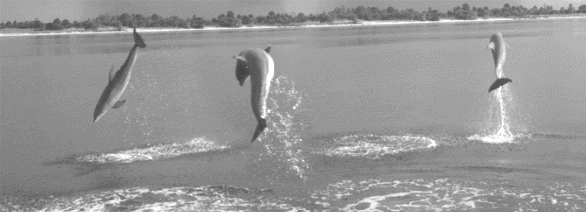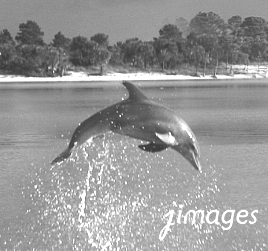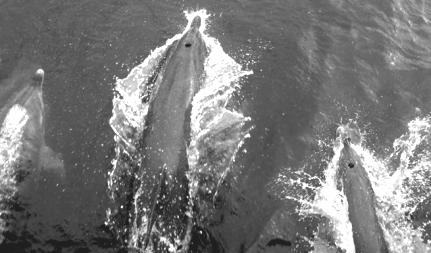“To the dolphin alone, beyond all other, nature has granted what the best philosophers seek: friendship for no advantage.” … Plutarch
“Your imagination is your preview of life’s coming attractions.” … Einstein

Three dolphins, suspended like angels, are floating forever, caught in mid-leap with a digital camera. The water spray explodes from their sleek bodies and glistens in the Florida sun. These are wild dolphins. They were not chattering away like Flipper. The image of them is not a photograph of captive dolphins posed to leap simultaneously in a sea park water tank, but three separate pictures of single wild dolphins jumping, layered into a .psd image and combined into a Photoshop montage.
August first dawned clear and sunny. East of Pensacola near Saint Joseph Island in the Florida panhandle, I was making pictures for Jimages, my company, when three dolphins swam parallel to shore and then approached. One dolphin broke away from the pod and cruised alongside the white hull of our catamaran as it lay at anchor in ten feet of teal-blue water. We were surrounded by silence–no wind, just calm, glassy water.
Suddenly, a dolphin broke the surface and catapulted twelve feet into the air.

The dolphin arched its body, exposing a pink belly, splashing tail flukes, and smiling bottlenose. Twisting eight feet out of the water, it somersaulted back in with a splash, still grinning.
Unexpectedly, two more dolphins jumped in sequence. Each leap happened like lightning followed by a loud splash. The dolphins broke the water with wild energy and soared into a different world for the joy of it. There were no crowds–no others humans around.
Seeing these wild mammals jump inspired me. I searched for everything I could read about their intelligence. Dolphins, I learned, live in two worlds. Masters of the marine world below the water’s surface, they can also leap out of the sea for distances up to three times their body length. For perspective, think of the last time you jumped up to a two-story balcony. Dolphins are extraordinary athletes.
Dolphins breathe much more effectively than we do and can hold their breath much longer. They are known to be “conscious breathers,” meaning they breathe out and exchange air in their super-efficient lungs whenever they choose. Plus, they can smile.
Dolphins are noted to have an exquisite sense of humor. They will sneak up behind an unsuspecting pelican floating on the water and pull off its tail feathers. Underwater, one diver saw a dolphin teasing a goliath grouper. The dolphin kept placing a morsel of squid near the grouper’s rock cranny, but he would snatch the bait away just as the grouper came out.
Dolphins are notorious for rescuing men. At times, sailors feared lost at sea have shown up on shore with stories of dolphins towing them to land. Dolphins have been reported to guide ships into harbor. Truly, the dolphin offers its friendship for no return advantage.
Pursuing a perfect dolphin shot, I’d taken many pictures of dolphins in the previous year. However, it was a unique experience to have them jump so close to the boat. Reviewing my digital shots on the camera’s liquid crystal display screen, I found I’d made seven pictures without any awareness of either the camera or myself as the surprising beauty of airborne dolphins mesmerized me. I put my pictures aside for a while. During this time, my imagination worked to determine how the final image might look.
Imagination is not bound by time. The final composite image took me about three weeks. I considered several ideas and discarded them. At first, I imagined two dolphins jumping side-by-side. Wouldn’t that be great! I didn’t use that idea, however, as some days later a different idea emerged. Wouldn’t it be a challenge to try to capture an image that referenced the two worlds dolphins inhabit–air and water?
I find quotes are helpful to my image-making process. Poetry, songs, and masterworks of painting can also fuel my imagination. In this case, my father sent me a quote by Albert Einstein about imagination. (See above) It was not until the following week, while I was merely daydreaming in bed with the camera at my side, that the idea came to me for the final image of dolphins in two worlds.
Turning on the LCD preview on the back of my camera, with Einstein’s idea about imagination running through my mind, I scanned the images, one after another. Suddenly, the idea came for a composite of all three jumps in which the dolphins seemed magically suspended. This was a novel view of them that I hadn’t seen in reality, only in my mind’s eye.
Your creative process can take ordinary pictures and raise them to the level of artistic creations. This does not happen on its own. Bringing your own individual ideas to your images is what makes you a visionary. Specific imaginative leaps and associations that only you make become a vital part of Photoshopping and make your work distinctive.
Photoshopping is creating imaginative scenes with a computer using software. It is practiced by anyone seeking entertainment, humor, spiritual practice, or competition. Photoshopping is an emerging art form after the year 2000 that will grow to include multimedia and street performances as Photoshop artists become more mobile.
Digital photography is digital thinking. There are differences in the thinking involved between photographing and Photoshopping. When I photographed dancing dolphins, I lost track of time. I didn’t even bring the camera to my eye but kept shooting instinctively, from the hip. The pictures recorded sudden, unexpected, decisive moments. Just a 50 mm lens with a limited perspective helped capture the moment. Practice and habit helped me prepare the camera ahead of time, point it from the hip, and then keep photographing more than necessary to capture only a few sharp images out of the rest.
Photoshopping the event, though, involved post-visualization. Dreams, ruminations, and daydreaming all contributed to the process of making a collage. Creating the composite drew from imagined scenes and my prior memories of pods of dolphins as the image developed multiple perspectives with several layers. The Photoshopping method followed a workflow and several versions of the image emerged.
“Photoshopping is about aspiration, not acquisition. When your imagination is on fire, visualizing how your image might look, that’s Photoshopping.”

Don’t be confused by the term, however. Photoshopping is about aspiration, not acquisition. When you photograph and your imagination is set on fire as you visualize the way your pictures might look, that’s Photoshopping. You can do it with Bryce, Painter, Vellum, CAD or any visual creation software. It’s not reserved only for those at play in the fields of Adobe.
And, speaking of play, the best images may be those in which a playful friendship exists between the photography and the Photoshopping. This friendship grows as you create a seamless workflow between your image capturing, image editing, and printing. Making the workflow seamless, for me, involves practice and an economy of equipment. I try to make all my digital equipment portable, so that when I’m in the field I can edit the digital images right away. This immersion into the image-making process is filled with rewards, once you do it enough to get rid of the software and hardware bugs.
You don’t need the latest lens and camera. In fact, the more your digital thinking and focus are on only the subject and not your equipment, the better your images will become. Given the power of what you can do with the computer, one lens and one camera body are plenty of equipment. For example, if I’d had a zoom lens and spent time changing focal length, by the time I clicked the shutter, the dolphins would have been long gone.
Perhaps your imaginative leaps will leave you like the dolphin–dancing and smiling with the joy of leaping into a completely new world.
by James Austin M.A. , A.C.E.

Leave a Reply